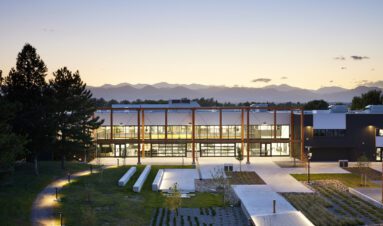Ellie Caulkins Opera House
14th Street and Curtis Street
Fast Facts
Architect: Robert O. Wilson Semple Brown Design
Architectural Style: Classic Lyric Format
Year Built: 1908
Designation: National Historic Landmark
Neighborhood: Downtown
Original Building: Municipal Auditorium
Handicap Accessible
Ellie Caulkins Opera House
The Neoclassical Denver Municipal Auditorium was constructed in response to Mayor Robert Speer and other Denver boosters’ desire for a large auditorium, as early as 1899, when voters approved a $400,000 bond for its construction. It took another bond issue in 1904 and much argument over location before the cornerstone was laid in 1907. The auditorium officially opened July 5, 1908 and was located in the historic downtown neighborhood, among other prominent government, public and cultural buildings.
The original structure featured four cupolas on the roof, and 7,000 light bulbs highlighted the pediments, domes, cornices and corners. Terra cotta symbols of music and theatre decorated the outside pilasters. The interior boasted a 246-by-145-foot hall, separate meeting chambers for men and women, dressing rooms, an orchestra pit, a removable running track and a dance floor. The hall could be converted to a theatre with a ten-ton proscenium arch that spanned 60 feet wide and 50 feet high, and was stored in the ceiling. In just four hours the giant hall could be transformed into a theatre with over 3,000 seats, complete with balconies that were brought out from the walls.
The 2,100 seats in the current performance space are arranged in four tiers, and the farthest seat from the stage rests 113 feet away. In order to provide the best acoustics possible, the theatre is designed in a lyric shape, and many surfaces are cherry veneer over plaster. The Figaro seat back titling system allows audience members to see either English or Spanish translations of opera libretti during performances.
In 2001, the exterior was renamed the Quigg Newton Denver Memorial Auditorium. Shortly after, in 2002, Denver voters approved a proposal to restore the outdated and unsafe auditorium theatre, which was designated as a landmark by both Denver and the National Register of Historic Places, and to create an opera house within its walls. Funds for the restoration came from a prior $25 million general obligation bond, an existing seat tax, the Colorado Historical Society’s gaming tax preservation funds and private donations. Exterior stone and trim were repaired or replaced, some of the light bulbs were reinstalled and the entrance was moved from 14th Street to the Galleria of the Denver Performing Arts Complex, complete with the original wooden door and window frames. Preservationist Rick Geiser of Semple Brown was in charge of the exterior modifications. The 14th Street entrance was replaced with new plinths that exactly matched the original ones, and most of the bricked-in windows were returned to their original state.
References
Noel, T. and Zimmer, A. (2008). Showtime: Denver’s Performing Arts, Convention Centers & Theater District. Denver, Colorado: Denver’s Division of Theatres and Arenas.
Voelz Chandler, M. (2013). Guide to Denver Architecture. Denver, Colorado: Fulcrum Group.
National Register of Historic Places, Denver Municipal Auditorium, Denver, Denver County, Colorado,National Register #91001531.
Map
Ellie Caulkins Opera House
14th Street and Curtis Street, Denver, Co
Nearby Sites
View All
Equitable Building
Equitable Building The Equitable Assurance Society of New York built the Equitable Building in 1...
More Info